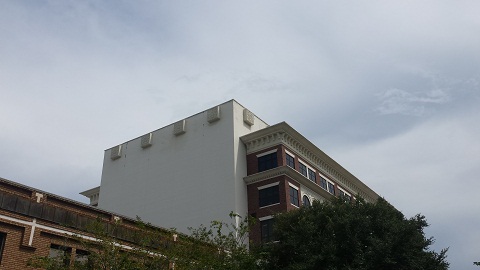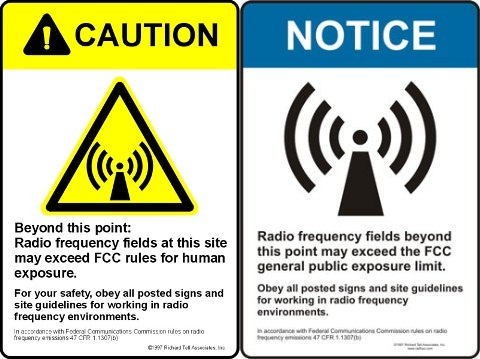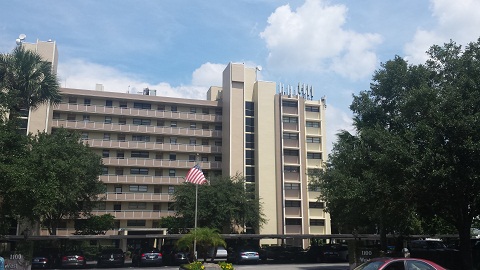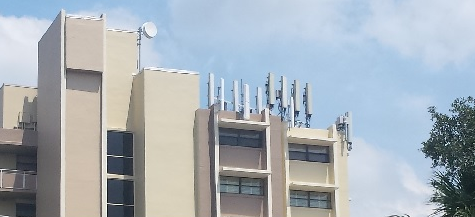Cellular telephone transmission sites are most commonly found on standalone towers, however, building rooftop cellular transmission sites are becoming more and more common. These rooftop transmission sites are certainly something that all firefighters should be aware of. These sites pose a unique threat to firefighters operating on or near the roof in the form of a Radio Frequency (RF) exposure.
Most commonly the cellular transmission sites that are found on towers are made of of 3 sectors (or panels) of antennas 120 degrees from each other. Typically when they are installed on roofs, the antennas consist of 4 sectors (or panels) of antennas, one for each side of the building. Each sector (or panel) is typically made of of 3 high gain antennas, with the middle one dedicated to transmitting and the two outside ones dedicated to receiving. With the increase demand for bandwidth of today’s phones (think internet access), many cellular providers are increasing to 4 antennas per sector.
The most common frequency ranges that are found on cellular transmission sites are in the 824-849MHz, 869-894MHz and 1850-1990-MHz bands. Just for comparison, the most common public safety radios operate in the 769MHz-800MHz, 806-824MHz, and 851-854MHz range. As you can see our radios operate very close to some of the cell phone frequency spectrum, and that’s what that whole re-banding thing was all about. It is worth mentioning that our radios operate at a much lower power (3-5 watts) compared to cellular transmission sites (up to 500 watts) so there are no RF energy issues to be concerned with in regards to our radios.
One of the most challenging parts of working around these antennas is simply identifying their presence. Often times the antennas are hidden behind fiberglass covers for aesthetic purposes. So easily detecting their presence from the street might be next to impossible. One of the only obvious indications of their presence may like one of the signs shown below posted on the stairwell door providing roof access. This sign is required by the FCC when certain levels of RF energy are present on the roof. Unfortunately this sign will not alert us when we are accessing the roof via the aerial ladder.
There are many variables when determining the amount of RF energy that is present at each antenna site. It depends on the power output and number of radio channels or transmitters that are present at each site. The FCC permits up to 500 watts per channel, but often times only 100 watts is found in rooftop sites. For our purposes on the fireground it really doesn’t matter the actual power output. We should treat every cellular transmission site like it is capable of producing high levels of RF energy that can significantly hurt us.
The RF energy produced from these antennas is non-ionizing radiation, similar to the energy found in a microwave oven. So the major concern of RF energy exposure is over heating of the human body. Just like those leftovers in the microwave, if your body is in the path of the RF energy you could be heated to a well-done temperature. If you must be around the antenna, a good rule of thumb is to remain behind or under the actual panel of the antenna. The reason this works is because cellular transmission antennas utilize very directional antennas. Essentially all of the energy is focused out the front of the antenna. This is why being below or behind the panel is the safest place if you must be near it for any reason.You never want to allow your head to be in line with the transmission pattern of the antenna. The further away you are, the less energy you will be exposed to. It should go without saying, but never touch the actual antenna.
Besides the RF issues, these cellular sites often present other hazards such as tripping hazards and additional electrical issues. The cable trays mounted on the roof could easily be obscured by smoke causing a tripping hazard. Most radio rooms will also be serviced by a backup generator that will be independent of the buildings primary electrical system. In addition, the site will have battery backup systems as well. So it would be very difficult for us to ensure that all power has been isolated from the equipment.
One of the best things to remember when operating around rooftop cellular antennas is to simply to apply the HazMat mantra of Time, Distance, Shielding. While RF shields are available for certain applications, they have no practical use for us while accessing a rooftop during fireground operations. Simply stay as far away from the antenna as you can, and if for any reason to need to pass in front of one, do it quickly. Time and Distance can minimize your exposure.
If you are curious about the possible location of any cellular transmission sites in your area, there is a free website that will show all sites within a 4 mile radius of a particular address. It may not list every single site, but it’s pretty comprehensive and certainly seems like a fairly accurate tool for planning purposes.
The picture above shows a “hidden†cellular transmission site. The four squares are found on each side of the building are each hiding one panel antenna. This particular building has a total of 16 antennas, four on each side. If you found yourself operating on the roof, you could see that your head could be very close to the transmission pattern of the antenna.
The picture above shows a two different cellular transmission setups. There are two sets of panels that are focused on side A of the building. This just shows that there are two different cellular providers on this building. You can just barely begin to see one of the panels on the D side as well. This particular style of installation is more hazardous to a crew accessing the rooftop from the aerial ladder. You would be perfectly safe to be standing behind these panels since the RF energy is focused out the front. Having said that, if you don’t need to be close to the antenna, simply stay away. Look at the windows just underneath the antenna panels, it just demonstrates how the RF energy is in fact focused straight out.
The picture above shows another style of roof top transmission sites. This particular setup is more hazardous to the team operating on the roof. Although its hard to tell from the picture. These panels are slightly set back on the roof. This creates a situation where someone could walk directly in front of the panel and directly into the transmission beam. You can also see that the radio room structure has been added to the rooftop of the building. This style of installation would have the trip hazard from the cable trays present in-between the radio room structure and the antennas.






It is worth emphasizing that RF is not like a flashlight, it does funny stuff, so standing to the side of a directional antenna may be giving you a lot of radiation. Not enough that it distracts from the signal, but at 18″ a lot of power. Some antennas are cylinders (for weatherproofing purposes) or so close you cannot tell the direction they fire at a glance. So, don’t assume anything, and stay away from these for long periods at least.
The tower companies will have emergency numbers posted (FCC requirement), and they are 24×7 manned sites, that take this all seriously. They have a lot of incidents due to their scale so should pick up the emergency number right away and if things like where the power cutoff is in a book they can get to immediately. Note the other stuff on the sign. There is a site operator and SITE ID that they may need, or which your county emergency service guys can use to coordinate for you. Relay that, not just the address as it’ll speed things up if you have someone not on the roof handling this for you.
Lastly, these have enough power themselves they catch fire periodically. You may have to respond to the actual equipment being on fire, and should keep all these safety precautions in mind especially then.